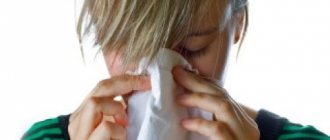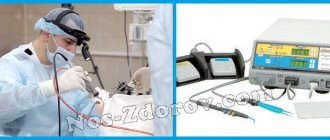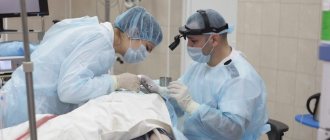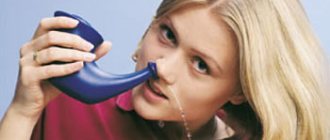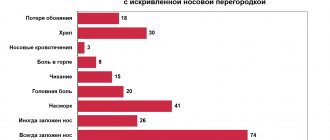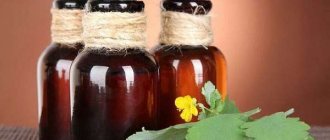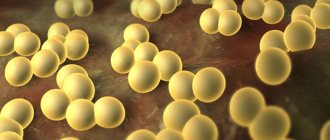Symptoms of pathology
Such growths initially form in the upper regions of the nasal cavity. Over time, they grow and cause blockage of the respiratory lumen. The patient has difficulty breathing through the nose. Therefore, this function is often performed with the mouth.
This pathology reduces performance, causes headaches, and provokes chronic fatigue.
Removal of nasal polyps is recommended for the following problems:
- cessation or partial disruption of breathing through the nose, causing discomfort in the patient;
- the occurrence of snoring;
- loss of smell or its severe deterioration;
- recurrent sinusitis;
- attacks of bronchial asthma, especially frequent;
- deformation of the nasal septum.
Diagnostics
Only an ENT doctor can recommend removal of nasal polyps. He will examine the cavity using a special instrument - a mirror or an endoscope. Based on this, an appropriate diagnosis can be made - “polyposis ethmoiditis”.
Radiography will allow you to determine the extent of the process. In this case, computed tomography is most preferable. It will allow us to determine in more detail the inflammatory process in the paranasal sinuses. Sometimes histological examination of tissue may be required.
Based on such studies, surgery will be proposed. Removal of nasal polyps can be done using several methods. Each of them involves endonasal conduction - through the nasal passages. No incisions are made on the face.
Treatment of nasal polyps
Treatment of polyps depends on the stage of the disease and the cause that caused the growth of the nasal mucosa. If the size of the polyps is small, the doctor will prescribe medication.
For allergic rhinitis, which is one of the causes of the disease, a number of allergy tests are performed. This is necessary in order to determine what exactly causes the allergy. After this, it is necessary to avoid contact with this substance and undergo a course of treatment with antiallergic drugs (Loratadine, Cetirizine).
If the cause is chronic inflammation of the sinuses, then these diseases are treated with antibiotics (Macropen, Ceftriaxone).
In the case when polyps are caused by aspirin intolerance, it is necessary to exclude from the menu all foods rich in salicylates (strawberries, gooseberries, cherries, currants), some food additives and dyes. Also stop taking all non-steroidal anti-inflammatory drugs that contain acetylsalicylic acid.
Treatment with topical steroids (Beclomethasone, Mometasone, Fluticasone) helps reduce the size of nasal polyps, relieve inflammation and swelling of the mucous membrane. They provide a good therapeutic effect, but have a significant drawback. Treatment requires large doses of steroids for a long time, which can cause serious side effects. For treatment, mast cell membrane stabilizers are used - cromoglycates (Ketotifen, Sodium Cromoglycate), which can stop the release of histamine in the body. This substance causes allergies, swelling of the mucous membranes and increased activity of the respiratory tract.
In recent years, immunotherapy has become widespread. To restore the functions of the immune system, immunocorrective drugs of bacterial origin are used (Ribomunil, Polycomponent vaccine VP-4). They contain bacterial antigens and nonspecific immunomodulators in the form of lipopolysaccharides. These drugs cause the body to produce special antibodies that increase immunity.
In the event that the patient consults a doctor at a late stage or when drug treatment does not produce results, surgery may be prescribed to remove polyps.
Indications for surgical removal of polyps are:
- frequent attacks of bronchial asthma
- complete nasal congestion
- bloody or foul-smelling nasal discharge
- severely deviated nasal septum
- inflammation of the paranasal sinuses
- snore
- disturbances of smell and taste
Preparation for surgery necessarily begins with a complete examination of the patient. This is necessary in order to determine the state of health and identify possible contraindications. You need to tell your doctor:
- About what medications the person is taking (for example, anti-inflammatory birth control pills)
- About the presence of chronic diseases
- About problems with the cardiovascular system
- About cases of allergies to medications and other substances
To determine the structural features of the nose, diagnose inflammation in the sinuses, and identify a deviated nasal septum, radiography or computed tomography is performed.
Be sure to do blood tests: general, biochemical, coagulability.
Medication preparation for surgery:
- 10 days before the procedure, Ketotifen is prescribed to eliminate allergies.
- 3 days before surgery, daily administration of Dexamethasone solution is prescribed to prevent inflammation, allergic reactions and swelling.
- On the eve of the operation, sleeping pills and a cleansing enema are usually prescribed.
- A few hours before surgery, a 2% solution of Clemastine (an antiallergic and sedative drug) is administered.
- An hour before the procedure, an injection of diphenhydramine (3-5 ml of 1% solution intramuscularly) and atropine sulfate (subcutaneously 1 ml of 0.1% solution) is given; they have an analgesic and sedative effect.
Removal using a shaver
This operation is performed with a special surgical device. It's called a microdermbreeder. The doctor monitors all actions on the monitor while removing polyps. Formations are removed as accurately as possible from all affected areas of the mucosa.
Removing nasal polyps with a shaver involves breaking them up, crushing them, and sucking them out of the nasal cavity. Such a device affects the ethmoid labyrinth - the area of tumor growth.
Shaver not only removes polyps. Its use is quite effective for correcting anatomical defects and deviations in the mucous cavity. These operations relieve patients from unwanted symptoms such as nasal congestion and snoring.
These interventions involve the use of local anesthesia. If the patient wishes, general anesthesia is used.
The effectiveness of the operation is quite high. Relapses are practically not observed. The intervention is almost bloodless. The patient needs light rehabilitation. There are no complications after the operation.
Further recovery
After several days in the hospital (usually no more than two or three), the patient is discharged for outpatient treatment. At this time, it is more important than ever to strictly follow the doctor's instructions in order to restore your sense of smell after removal of nasal polyps. Conditions for successful recovery include:
- predominantly home regime - the mucous membrane, inflamed after surgery, is unable to resist the infection that is inevitably present in public places and poses a danger to the body of the person undergoing surgery;
- impeccable cleanliness of the premises - daily wet cleaning not only reduces the number of microbes in the surrounding space, but also increases air humidity, which is an additional factor in recovery after removal of polyps, and helps restore function;
- absence of significant physical activity in the first month - without excessive tension, the vessels do not forcibly dilate, including on the nasal mucosa, which means there is a gradual decrease in postoperative edema;
- refusal of thermal procedures to avoid increasing pressure in the capillaries of the mucous membrane and in blood vessels in general;
- a diet rich in vitamins (A, C, PP, group B) will provide the necessary vitality, activate immune defense and strengthen blood vessels;
- Regular compliance with medical prescriptions, nasal care measures, visiting a physiotherapy room and taking procedures will help restore your sense of smell as soon as possible;
- protecting the operated area from re-injury - eliminating the conditions for the formation of dry crusts on the surface of the nasal mucosa through daily inhalation or irrigation;
- restriction of movement - traveling by plane with a change in climate zone to a warmer one is extremely undesirable during this period (change in pressure), and swimming in open water is fraught with infection and injury.
If these simple rules are followed, the sense of smell can be restored quite quickly after removal of polyps in the vast majority of cases.
Important! Do not overuse vasoconstrictor nasal drops. The medications prescribed by the doctor are used strictly in the prescribed dosage. Otherwise, paradoxical persistent vasodilation and rehabilitation complications are possible.
Laser removal
This operation is the most effective and high-quality treatment method. Removal of nasal polyps with a laser is performed once. In this case, the result remains forever. The laser eliminates the polyps themselves, their bases, and also rids the body of the tissue that makes up these formations. The procedure is performed under local anesthesia.
The laser beam, which has beneficial properties, promotes the sealing of blood vessels and produces an antiseptic effect. This allows you to automatically disinfect the surgical area and makes the operation bloodless. In addition, laser removal of nasal polyps is sterile. There are no complications after the operation. The patient returns to normal life very quickly.
These operations are allowed for people diagnosed with bronchial asthma. The only drawback of the method is the possibility of its use for single pathologies. If multiple polyps are observed, this method is not used.
Endoscopic polypectomy
This is the newest method. Endoscopic removal of nasal polyps guarantees minimal trauma to the patient. The risk of relapse after such an intervention is the lowest.
During the operation, the doctor has access to all parts (even the most difficult to reach) of the nasal cavity and paranasal sinuses. The doctor watches his manipulations on the monitor. A high-precision device allows you to remove pathology with millimeter precision. Bleeding during the intervention is in most cases insignificant. During surgery, the surgeon can correct a deviated septum.
This intervention is performed under general anesthesia in a hospital. The rehabilitation period lasts from 3 to 7 days.
After removal of nasal polyps, you are not allowed to eat hot food for several days. It is forbidden to blow your nose. Crusts or loose mucus should be carefully removed. The sense of smell is restored within a month.
Patients are advised to rinse their nasal passages with special solutions. The following tools are suitable for such purposes:
Recovery
During the recovery period, the patient must take an antibiotic to avoid complications such as inflammation.
Complete recovery after surgery depends on the technique and volume of intervention and lasts from several days to a week. At this time, the patient is advised to avoid crowded places and exposure to sunlight. You should not be in unventilated areas, and also do not engage in physical labor. The doctor does not prescribe a special diet, but the food should not be hot, as this can cause bleeding. Drug treatment after removal of nasal polyps is aimed at restoring the membranes, preventing complications and relapses. For this purpose, the following groups of drugs are prescribed:
- Antibiotics. Will help to avoid postoperative inflammatory complications.
- Saline solutions. Hygienic care of the nasal cavity using saline solution of sodium chloride, Humera or Aqua Marisa will clean and moisturize it.
- Oily or hormonal nasal products. Promote mucosal regeneration and prevent the formation of adhesions.
- Antiallergic. "Cetrin", "Suprastin" or "Aleron" will help relieve swelling.
Rehabilitation after removal of nasal polyps can be supplemented with physiotherapeutic procedures. For example, UHF, laser or magnetic therapy, as well as traditional medicine.
Surgical intervention
This is a radical method. It is used in complicated cases. Indications for surgical intervention are the following:
- severe difficulty breathing through the nose;
- purulent inflammatory process in the paranasal sinuses or nasopharynx.
This method has contraindications. This operation is not performed for bronchial asthma, bronchitis (chronic) in the acute stage. It is not recommended to produce it during the flowering period of plants that can provoke allergies.
This method is quite complicated. The operation is performed under general anesthesia. The patient needs careful preparation for the intervention and further rehabilitation.
After surgery, it is mandatory to prescribe drug treatment aimed at reducing the risk of infectious and viral complications.
Cost of the operation
The pricing policy depends on the medical center where polyps are removed. The cost and complexity of the disease is taken into account. In many Moscow clinics, laser removal of nasal polyps is quite successful. The price of such an operation ranges from 10,000 to 30,000 rubles.
Surgical intervention can be performed in a public medical institution or you can choose a clinic yourself.
Many people opt for surgery using a shaver. It was described above that it also allows for effective removal of nasal polyps. The price of the operation in this case varies from 4,000 to 8,000 rubles.
Types of operations
Surgical treatment of nasal polyps is carried out in different ways. The choice depends on the localization and extent of the pathological process. The following operations are recommended:
- Ordinary polypotomy. Traumatic intervention with a cutting loop, using local anesthesia.
- Removal of nasal polyps with laser. It is performed on an outpatient basis, under endoscopic control. Since it is not painful, this type of intervention is recommended for children. Laser removal of polyps is performed for polyps localized in the nose.
- Endoscopic shaving intervention. Removal with a shaver and extraction of tumors in the nose and paranasal sinuses reduces the operation time and trauma to surrounding tissues. An endoscope is used to observe and display the progress of the operation on the monitor. Shaver removal is performed under general anesthesia.
- Radio wave method. Not used to remove small polyps. Cauterization is carried out at the same time, as a result of which postoperative bleeding does not occur.
Patient opinions
There are quite contradictory reviews about such an operation as the removal of nasal polyps. Some were satisfied with the laser intervention. This procedure, according to their testimony, made it possible to breathe through the nose again.
Other patients, on the contrary, testify that some time after such an operation the polyps grew again. They insist on endoscopic polypectomy, basing their choice on excellent results. According to such patients, they quickly began to smell a variety of odors. The effect lasted for a long time.
The third category of patients insists on surgery using a shaver. They not only support their opinion with excellent results, but also focus on the convenience and speed of surgical intervention.
source
Laser removal (treatment) of nasal polyps
Performing surgery using a laser
in modern otolaryngology it becomes popular from year to year. When nasal polyps are removed using a beam, the inflammatory process in the nasal passages is minimized. The laser does not cause bleeding during surgery. The rehabilitation period is minimal, most often without complications or pathologies.
In general, surgical intervention on ENT organs using a laser beam does not have a negative effect on the human body. Contraindications are kept to a minimum.
Stop removing polyps, there is a more humane way to treat it! You can find it here.
Stages of development of nasal polyps
Polyps are a disease that needs a certain time to finally gain a foothold in the human body.
Therefore, its development in the nasal cavity can be divided into 3 stages:
1. First stage.
At this stage, the neoplasms are just beginning to emerge and therefore do not cause much discomfort when breathing.
2. Second stage.
At this stage, the tissues grow to such a size that they almost completely close the respiratory canals. But despite this, a person still has the opportunity to breathe.
3. Third stage.
At this stage, the nasal canals are completely blocked and the person loses the ability to breathe through the nose.
Removal of nasal polyps with laser
Removal using a laser beam is effective and safe. Many patients who have contraindications to the traditional method of treatment can undergo such a surgical procedure. People suffering from bronchial asthma can remove polyps using a laser. Surgical intervention has low morbidity, minimal rehabilitation period and many advantages.
You can determine the presence of nasal polyps using modern diagnostic methods.
Indications and contraindications for laser treatment of nasal polyps
Consultation with a doctor before laser removal of polyps
The laser beam does not have any adverse effects on the human body, however, in order to carry out surgery using it, it is necessary to take into account the indications and contraindications.
Indications for laser removal:
- Deviated nasal septum with existing polyps.
- Proliferation of polyps as a side effect in bronchial asthma.
- Permanent lack of sense of smell.
- Snoring during sleep.
- Difficulty breathing or complete absence of it.
- Rhinosinusitis, sinusitis.
Contraindications to the use of laser for polyposis:
- The use of laser is prohibited for patients with blood clotting problems.
- In the presence of malignant neoplasms.
- Impaired blood supply to the brain.
- For diseases of the cardiovascular system and hypertension to an extreme degree.
- Pregnancy throughout all three trimesters.
- Natural breastfeeding.
- Presence of obstructive bronchitis.
- Multiple growths of polyps in the nose.
- The period of strong allergic reactions during the flowering of plants (spring and autumn).
Causes of nasal polyps
Most people neglect diseases of the nasal cavity, adhering to the position that a runny nose is not a big deal and “will go away on its own.” But this is not a true statement. Patients are at risk of serious complications.
The main causes of foreign formations in the nasal cavity are:
1. Constant colds, which are accompanied by a runny nose.
2. Inflammation of the maxillary sinuses.
3. Kartagener's syndrome.
4. Bronchial asthma.
5. The presence of microorganisms in the body that provoke nasal discharge.
6. Manifestation of allergic reactions.
- The most common cause of polyps today.
— Factors that cause such allergic reactions: poor diet, poor environment, and so on.
7. Various injuries of the nasal septum.
8. Very often, the predisposition to neoplasms is inherited.
9. Weak immune system.
Progress of surgery to remove nasal polyps with laser
A doctor uses a laser to remove a polyp
Progress of surgery:
- The patient is seated on a specialized chair.
- The doctor explains the upcoming procedure and talks about its consequences and possible complications.
- After this, the specialist administers anesthesia by injection.
- Removal is carried out according to the image displayed on the screen using an endoscope. At the tip of this surgical device there is a camera and a light, the video of which is transferred to the monitor.
- The specialist inserts an endoscope tube and laser equipment into the nasal passage.
- The beam heats the neoplasms, during which the amount of moisture in the polyps decreases, they are removed and evaporate.
- The laser beam also seals blood vessels, which prevents nosebleeds.
Photo gallery:
The percentage of infection in the wound is minimal. After surgery to remove nasal polyps using laser equipment, hospitalization is not required. The patient goes home and returns for an appointment with a specialist on the specified day.
You can read about other methods of polyp removal and postoperative recommendations in our article.
Recommendations from a specialist after surgery:
- Do not drink alcoholic beverages.
- Limit physical activity.
- Do not bend forward.
- Do not visit establishments with sudden temperature changes, including baths and saunas.
How I had nasal polyps removed
For several years now, polyps have been growing in my nose and preventing me from breathing normally. I was treated with Tafen spray, which helped me well. But since I also have chronic sinusitis, and a serious exacerbation of the disease happened to me, I still had to resort to surgical treatment. The operation is performed in a hospital using a shaver (endoscope). If you want to get it quickly, pay money; if you want free treatment, wait a few months. At first, I collected a bunch of tests (general blood and biochemistry, blood group test, HIV and hepatitis test, urine test, fluorography, x-ray of the nose, ECG) and visited doctors (dentist, therapist). Then I came to the hospital with this information and they put me on the waiting list for a free operation. Before the operation itself, you need to take blood and urine tests again and get a physician’s opinion. And here I am in the hospital. In the morning I was given two intramuscular injections and I became drunk. I understood everything, but my coordination of movements was impaired. The nurse led me into the operating room by the arm. They put shoe covers up to my knees and scolded me for not tidying up my hair, to which I replied, “Give me a disposable cap,” and grumblingly they gave it to me. They put him on the table and covered him with a very thick white sheet with a slit in which only his nose and mouth were visible. Through the fabric I could only see the light from the lamp, I didn’t even see the outline of the doctor, and I can only tell you what he did based on my feelings. The anesthesia was local, they injected something into my nose, they didn’t give me an injection. The doctor talked to me, I could answer him. It wasn't painful, but it was sensitive. At first, with something sharp (like a stick with a sharp end), the doctor apparently cut off the stem of the polyps; it seemed to me that he was pressing on the nasal septum. I said "Oh" to let him know how I felt. In fact, the pain is bearable. It lasted seconds. Then the stick was removed and the doctor used a shaver to suck out the polyp. It doesn’t hurt at all, all you can hear is a “squelch-squelch.” And everything was repeated again several times. First in one nostril, then in the other. The whole operation, according to my feelings, lasted no more than 15 minutes. Scientifically it is called polypoethmoidotomy. After the operation, they tied a bandage under my nose because there was a little blood oozing out. But they didn’t put any tampons into my nose, as the doctor later explained, “so as not to torment me.” I was breathing well. I immediately fell asleep in the room. When I woke up, I realized that while you were lying down, your nose wouldn’t bleed; if you stood up and especially leaned forward, the blood immediately began to drip. But that only lasted the first day. The next day there was no blood at all. So. Because I had sinusitis, the doctor gave me a puncture the next day and placed a catheter, which I walked with for 2 days. They gave me a 20 cc syringe and saline solution and taught me how to rinse my nose, which I did every 2-3 hours. They also prescribed the antibiotic Glevo to kill all the germs. He helped me a lot, there were no complications. I was also prescribed IVs and physical therapy. I spent a week in the hospital. And now almost a month has passed since the operation. I’m breathing on my own, everything is fine and I’m very happy that I can live without droplets.
Who had nasal polyps (adults)? Write what you did.
Because You are not logged in. To come in.
Because you are not a trust user. How to become a trustee.
Because The topic is archived.
Because You are not logged in. To come in.
Because you are not a trusted user (phone number is not verified). Enter and confirm your phone number. Read more about trusts.
Because The topic is archived.
Because You are not logged in. To come in.
Because you are not a trusted user (phone number is not verified). Enter and confirm your phone number. Read more about trusts.
Because The topic is archived.
Because You are not logged in. To come in.
Because you are not a trusted user (phone number is not verified). Enter and confirm your phone number. Read more about trusts.
Because The topic is archived.
Because You are not logged in. To come in.
Because you are not a trusted user (phone number is not verified). Enter and confirm your phone number. Read more about trusts.
Because The topic is archived.
Because You are not logged in. To come in.
Because you are not a trusted user (phone number is not verified). Enter and confirm your phone number. Read more about trusts.
Because The topic is archived.
Because You are not logged in. To come in.
Because you are not a trusted user (phone number is not verified). Enter and confirm your phone number. Read more about trusts.
Because The topic is archived.
Because You are not logged in. To come in.
Because you are not a trusted user (phone number is not verified). Enter and confirm your phone number. Read more about trusts.
Because The topic is archived.
Because You are not logged in. To come in.
Because you are not a trusted user (phone number is not verified). Enter and confirm your phone number. Read more about trusts.
Because The topic is archived.
Because You are not logged in. To come in.
Because you are not a trusted user (phone number is not verified). Enter and confirm your phone number. Read more about trusts.
Because The topic is archived.
Because You are not logged in. To come in.
Because you are not a trusted user (phone number is not verified). Enter and confirm your phone number. Read more about trusts.
Because The topic is archived.
Because You are not logged in. To come in.
Because you are not a trusted user (phone number is not verified). Enter and confirm your phone number. Read more about trusts.
Because The topic is archived.
Because You are not logged in. To come in.
Because you are not a trusted user (phone number is not verified). Enter and confirm your phone number. Read more about trusts.
Because The topic is archived.
Because You are not logged in. To come in.
Because you are not a trusted user (phone number is not verified). Enter and confirm your phone number. Read more about trusts.
Because The topic is archived.
Because You are not logged in. To come in.
Because you are not a trusted user (phone number is not verified). Enter and confirm your phone number. Read more about trusts.
Because The topic is archived.
Because You are not logged in. To come in.
Because you are not a trusted user (phone number is not verified). Enter and confirm your phone number. Read more about trusts.
Because The topic is archived.
Because You are not logged in. To come in.
Because you are not a trusted user (phone number is not verified). Enter and confirm your phone number. Read more about trusts.
Because The topic is archived.
Because You are not logged in. To come in.
Because you are not a trusted user (phone number is not verified). Enter and confirm your phone number. Read more about trusts.
Because The topic is archived.
Because You are not logged in. To come in.
Because you are not a trusted user (phone number is not verified). Enter and confirm your phone number. Read more about trusts.
Because The topic is archived.
Because You are not logged in. To come in.
Because you are not a trusted user (phone number is not verified). Enter and confirm your phone number. Read more about trusts.
Because The topic is archived.
Because You are not logged in. To come in.
Because you are not a trusted user (phone number is not verified). Enter and confirm your phone number. Read more about trusts.
Because The topic is archived.
Because You are not logged in. To come in.
Because you are not a trusted user (phone number is not verified). Enter and confirm your phone number. Read more about trusts.
Because The topic is archived.
Because You are not logged in. To come in.
Because you are not a trusted user (phone number is not verified). Enter and confirm your phone number. Read more about trusts.
